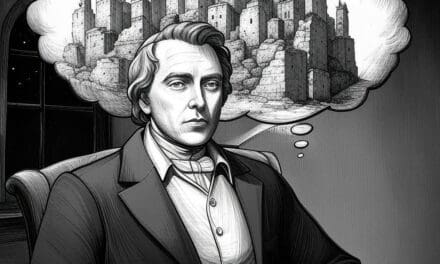The Trinity, as modern mainstream Christianity defines it—one God in three co-equal, co-eternal persons (Father, Son, Holy Spirit)—isn’t explicitly laid out in the Bible. It’s a doctrine that evolved over time, pieced together from scattered verses and formalized by church councils like Nicaea (325 AD) and Constantinople (381 AD). On the flip side, there’s a decent case in scripture for seeing the Heavenly Father and Jesus Christ as distinct beings in a literal father-son relationship, which aligns more with what some groups, like Latter-day Saints, argue. Let’s break it down.
Trinity in the Bible?
The closest the Bible gets to a Trinitarian formula is Matthew 28:19, where Jesus says to baptize “in the name of the Father and of the Son and of the Holy Spirit.” It’s one name, three players—suggesting unity but not spelling out “one essence, three persons.” Another hint is John 1:1-14, where “the Word” (Jesus) “was with God and was God” and became flesh, implying both distinction and identity with God. Then there’s 2 Corinthians 13:14, mentioning all three in a blessing: “the grace of the Lord Jesus Christ, and the love of God, and the fellowship of the Holy Spirit.” But these don’t say the three are co-equal or co-eternal—those ideas came later. The word “Trinity” isn’t in the Bible, and early Christians didn’t have a tidy definition. Some scholars point to Jesus’ baptism (Matthew 3:16-17)—Father speaks, Son’s in the water, Spirit descends—as a three-in-one moment. Yet, it could just as easily show three separate actors working together, not one being.
Father and Son as Distinct?
There’s stronger textual support for the Father and Jesus being a literal father and son, distinct from each other. Jesus constantly refers to God as “my Father” (e.g., John 5:17, “My Father is working until now, and I am working”). In John 14:28, he says, “the Father is greater than I,” which clashes with the co-equal part of the Trinity. At Gethsemane (Matthew 26:39), Jesus prays, “My Father, if it be possible, let this cup pass from me; nevertheless, not as I will, but as you will”—implying separate wills, not a single divine essence. The resurrection adds more weight. Acts 2:32 says, “This Jesus God raised up,” showing the Father acting on the Son, not the Son raising himself (though John 10:18 has Jesus saying he has power to take up his life again—bit of a wrinkle there). Post-resurrection, in Acts 7:55-56, Stephen sees “Jesus standing at the right hand of God,” picturing two distinct figures side by side. Paul’s letters often distinguish them too. In 1 Corinthians 8:6, he writes, “there is one God, the Father, from whom are all things… and one Lord, Jesus Christ, through whom are all things.” It’s a hierarchy, not a three-in-one mashup. Even the Holy Spirit gets treated more like a power or presence sent by the Father or Son (John 15:26, “the Spirit… whom I will send to you from the Father”), not a co-equal person.
Where’d the Trinity Come From?
The Trinity as we know it emerged as early church leaders wrestled with these texts and Greek philosophy—like the idea of “substance” (ousia)—to counter heresies. Arianism said Jesus was a created being, not eternal God; modalism said Father, Son, and Spirit were just modes of one God. The councils settled on a middle ground, but it’s more interpretation than a direct biblical quote. Critics say it’s a stretch from the Jewish monotheism Jesus himself taught (Mark 12:29, echoing Deuteronomy 6:4).
So, What’s More Biblical?
If you stick to the text alone, the Father-Son distinction has clearer footing—Jesus prays to the Father, submits to Him, and is exalted by Him (Philippians 2:9). The Trinity relies on reading between the lines and later theological glue. That said, Trinitarians argue those distinctions reflect Jesus’ human role, not his divine nature (e.g., Philippians 2:6-7, he “emptied himself”). It’s a debate that’s raged forever.
Trinity in the Bible?
The closest the Bible gets to a Trinitarian formula is Matthew 28:19, where Jesus says to baptize “in the name of the Father and of the Son and of the Holy Spirit.” It’s one name, three players—suggesting unity but not spelling out “one essence, three persons.” Another hint is John 1:1-14, where “the Word” (Jesus) “was with God and was God” and became flesh, implying both distinction and identity with God. Then there’s 2 Corinthians 13:14, mentioning all three in a blessing: “the grace of the Lord Jesus Christ, and the love of God, and the fellowship of the Holy Spirit.” But these don’t say the three are co-equal or co-eternal—those ideas came later. The word “Trinity” isn’t in the Bible, and early Christians didn’t have a tidy definition. Some scholars point to Jesus’ baptism (Matthew 3:16-17)—Father speaks, Son’s in the water, Spirit descends—as a three-in-one moment. Yet, it could just as easily show three separate actors working together, not one being.
Father and Son as Distinct?
There’s stronger textual support for the Father and Jesus being a literal father and son, distinct from each other. Jesus constantly refers to God as “my Father” (e.g., John 5:17, “My Father is working until now, and I am working”). In John 14:28, he says, “the Father is greater than I,” which clashes with the co-equal part of the Trinity. At Gethsemane (Matthew 26:39), Jesus prays, “My Father, if it be possible, let this cup pass from me; nevertheless, not as I will, but as you will”—implying separate wills, not a single divine essence. The resurrection adds more weight. Acts 2:32 says, “This Jesus God raised up,” showing the Father acting on the Son, not the Son raising himself (though John 10:18 has Jesus saying he has power to take up his life again—bit of a wrinkle there). Post-resurrection, in Acts 7:55-56, Stephen sees “Jesus standing at the right hand of God,” picturing two distinct figures side by side. Paul’s letters often distinguish them too. In 1 Corinthians 8:6, he writes, “there is one God, the Father, from whom are all things… and one Lord, Jesus Christ, through whom are all things.” It’s a hierarchy, not a three-in-one mashup. Even the Holy Spirit gets treated more like a power or presence sent by the Father or Son (John 15:26, “the Spirit… whom I will send to you from the Father”), not a co-equal person.
Where’d the Trinity Come From?
The Trinity as we know it emerged as early church leaders wrestled with these texts and Greek philosophy—like the idea of “substance” (ousia)—to counter heresies. Arianism said Jesus was a created being, not eternal God; modalism said Father, Son, and Spirit were just modes of one God. The councils settled on a middle ground, but it’s more interpretation than a direct biblical quote. Critics say it’s a stretch from the Jewish monotheism Jesus himself taught (Mark 12:29, echoing Deuteronomy 6:4).
So, What’s More Biblical?
If you stick to the text alone, the Father-Son distinction has clearer footing—Jesus prays to the Father, submits to Him, and is exalted by Him (Philippians 2:9). The Trinity relies on reading between the lines and later theological glue. That said, Trinitarians argue those distinctions reflect Jesus’ human role, not his divine nature (e.g., Philippians 2:6-7, he “emptied himself”). It’s a debate that’s raged forever.






